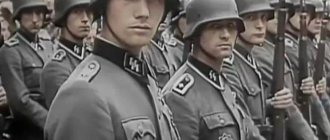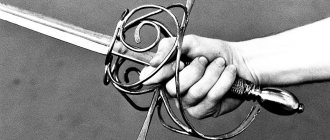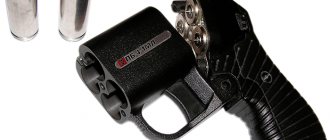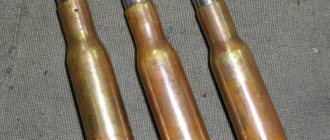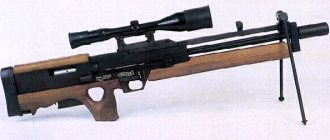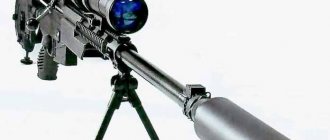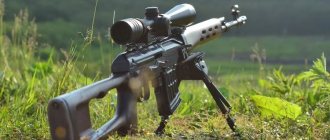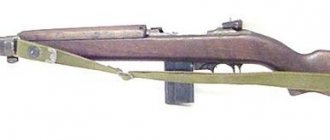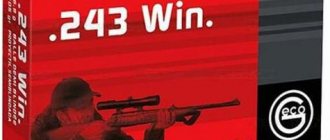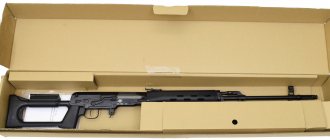7.62 mm rifle and machine gun cartridges
The 7.62-mm rifle (rifle-machine-gun) Russian cartridge is one of the most “ancient” long-lived among other small arms cartridges, since the first domestic rifle cartridge with a jacket bullet and smokeless powder was created for a 3-line repeating rifle mod.
1891 system of S.I. Mosin. On April 16, 1891, by the highest command of Emperor Alexander III (GAU order No. 124 of May 11, 1891), a new “3-line rifle cartridge of the 1891 model” was adopted into service with the Russian army, along with a 3-line magazine rifle and a cartridge clip.
3-line (7.62 mm) rifle cartridge of the year with a light bullet of the 1908 model in a cupronickel shell
After the end of the Civil War, military experts again turned to the issue of modernizing the main 7.62 mm rifle-machine-gun cartridge. In 1930, the Red Army adopted a whole complex of new 7.62-mm rifle-machine-gun cartridges with an improved light bullet model 1908 and with special-purpose bullets (“D”, “B-30”, “T-30” ). In the 1930–1940s, new 7.62 mm special rifle bullets were developed to solve special problems: “B-32”, “BT-32”, “BZT”, “3”, “P”, “BS-40” ", "T-46", and in 1938 the "3" and "P" bullets were replaced with the "PZ" bullet, and the "BZT" bullet with the "ZB-46" bullet.
CASES
If 7.62-mm rifle-machine-gun cartridges produced in 1891–1931 were produced only with a brass sleeve, then already in 1932 they received modernized sleeves - brass and even cheaper - bimetallic (i.e., made of low-carbon steel clad with tombac) . The bimetallic and brass sleeves of the 7.62-mm rifle-machine-gun cartridge of the 1930 model were almost identical and had a barrel shortened from 11.0 to 9.4 mm. Some changes were made to the geometry of the sleeve: the most noticeable of them was the change in the profile of the bottom of the sleeve from hemispherical, which caused delays in the operation of the automation of Maxim heavy machine guns, to trapezoidal; in addition, the slope of the cartridge case now had no curvature. The replacement of brass with bimetal for the manufacture of cartridge cases before the Great Patriotic War provided enormous savings in non-ferrous metals - up to 96%, previously used for the manufacture of cartridges. For example, if the transition to bimetal had not been possible, then 18,000 tons of brass and 4,800 tons of cupronickel would have been required to complete the rifle cartridge production program in 1940. Thus, in 1940 alone, all Soviet ammunition factories produced approximately 250 million 7.62 mm rifle and machine gun cartridges with a bimetallic sleeve. The ability to mass-produce the most common small arms cartridges with cheap steel casings was a major technological breakthrough and became one of the largest achievements of the Soviet defense industry in the pre-war period.
During the Great Patriotic War, a significant part of 7.62-mm rifle-machine-gun cartridges were produced using simplified technology, in cartridges without a protective tombac coating (the so-called “surrogate”). These sleeves were made of cold-rolled steel P18 YA without a protective coating and were not specially protected from corrosion in any way; only a layer of technological contact copper plating remained on them. Since the beginning of 1942, a significant part of the gross rifle cartridges with light “L” and heavy “D” bullets was produced in “surrogate” uncoated cases. After the end of the war, production of these cartridges was discontinued.
At the end of the 1950s, the 7.62 mm rifle cartridge cases underwent a new significant modernization - the replacement of the protective anti-corrosion coating from tombac to varnish. Despite the complexity of this technology, its implementation turned out to be very profitable, since it made it possible to almost completely eliminate the consumption of highly scarce non-ferrous metals.
The production of 7.62-mm rifle-machine-gun cartridges with varnished steel casings was established in the 1960s, initially at the Ulyanovsk Machine-Building Plant, where during the war years a wealth of experience had already been accumulated in the production of 7.62-mm rifle cartridges with casings without a bimetallic coating, and then the Barnaul Machine Tool Plant. Currently in Russia, combat 7.62 mm rifle and commercial rifle cartridges are produced with three types of cartridges: - varnished steel - combat 7.62 mm rifle-machine gun and commercial 7.62 mm rifle cartridges - at the Barnaul Machine Tool Plant; - bimetallic - combat 7.62-mm rifle-machine-gun and commercial 7.62-mm rifle cartridges - at the Novosibirsk Low-Voltage Equipment Plant; - brass - only 7.62 mm "Extra" sporting cartridges and their hunting modifications - at the Novosibirsk Low-Voltage Equipment Plant.
BULLET arr. 1891
The bullet of the rifle cartridge model 1891 was cylindrical in shape, with a spherical head. This shape of the bullet provided it with sufficient penetration and damaging properties for that time, a high value of lateral load, contributed to good stability in flight, and, as a result, high accuracy of hits at significant ranges. Considering that there were no machine guns in the army at the end of the 19th century, and volley shooting was recommended to hit group targets at long ranges, this factor was of no small importance. The mass of the Model 1891 rifle bullet was 13.73 g, length 30.48 mm, maximum diameter 0.306–308 inches (7.77–7.82 mm). The bullet shell was made of cupronickel, an alloy of copper 78.5–80.5% and nickel 19.5–21.5%. The core of the rifle bullet model 1891 was made of lead with the addition of antimony). When fired from an infantry rifle model 1891, the bullet developed an initial speed of 615–620 m. From a distance of 50 steps, it pierced 16–35 one-inch boards. The standard shield of field artillery guns of that time, made of armor 3.5 mm thick, was pierced by a bullet model 1891 from a distance of 150 m. At the end of the 19th century, a similar design of a bullet for firing from an infantry rifle was common in most countries of the world.
LIGHT BULLET arr. 1908
Already in 1894, the chairman of the testing commission of the Okhtensky Powder Plant, G.P. Kisnemsky, proposed a new design of a light, pointed rifle bullet with an ogive-shaped head for a 3-line rifle cartridge of the 1891 model, but then, for a number of reasons, this proposal was not further developed.
After significant research and development work in 1908, a new 7.62 mm light rifle pointed bullet weighing 9.6 g was adopted by the Russian army. The new bullet has an increased diameter of its leading part to 0.310–0.312 inches (7.84–7.92 mm), and the thickness of the bullet shell has also increased from 0.3 to 0.51 mm, and the seating depth of the bullet in the case has decreased from 6. 9 to 5.0 mm. The shell of the new bullet remained cupronickel, and the core was made of an alloy of lead and antimony. A corrugated knurl appeared on the bullet to better secure it in the muzzle of the cartridge case when assembling the cartridge, and in the tail of the bullet there was a conical depression to expand it with powder gases and improve sealing, which was especially important when shooting from rifles with worn rifling. In addition, the recess in the bottom of the bullet slightly shifted the center of gravity of the bullet forward, which improved the dispersion characteristics and also made it possible to compensate for the thermal expansion of the barrel while maintaining the accuracy characteristics within acceptable limits. The new bullet's penetration ability has increased significantly. Thus, a pointed bullet pierced a steel shield 5 mm thick at a distance of up to 200 steps, while a blunt-pointed bullet model 1891 pierced a shield at a distance of only 25 steps. Although when shooting at a wooden monolith at a distance of 400 m, a pointed bullet penetrated it to a depth of 450 mm, a standard blunt-pointed bullet penetrated 800 mm. The lower penetrating ability of pointed bullets when firing at a wooden monolith is explained by their strong deformation when encountering a wooden obstacle at short range. Some deterioration in the accuracy of combat of the new light rifle bullet was considered not to be of decisive importance, since, according to the experience of the Russian-Japanese War of 1904–1905, the bulk of combat clashes occurred at medium (up to 800 m) ranges, and a significant difference in accuracy appears at long ( from approximately 2000 steps) ranges.
LIGHT BULLET “L” mod. 1908/30
In the Soviet Union at the end of the 1920s, due to the significant cost of cupronickel used in the manufacture of bullet shells, serious research work was carried out to replace it. The most suitable material for such a replacement turned out to be hot-rolled low-carbon steel. For better protection from rusting, as well as for good gliding of the bullet along the bore, the steel shell was covered with a layer of LT-90 tombak (an alloy of 89–91% copper and 9–11% zinc). Despite the fact that cupronickel was the most optimal material for bullet casings, and steel was inferior to it in this regard, all its disadvantages outweighed the economic advantages obtained when using steel as a material for bullet casings. This was especially important during the mass production of ammunition - billions of pieces. In addition, during testing of steel-jacketed bullets, it turned out that their accuracy was somewhat better than that of cupronickel-jacketed bullets. This was explained by the greater rigidity of the steel shell, which better held the bullet in the rifling.
The shell of the modernized bullet was made of bimetal (rolled strip of low-carbon steel grade 11 KP, coated on both sides with LT-90 tombac). In 1930, a modernized light rifle bullet was put into service under the name “7.62 mm light bullet “L” model 1908/30.” The leading part of the modernized light bullet received a slight taper with a maximum diameter at the bottom cut. Fastening the bullet to the cartridge case began to be carried out by crimping the barrel into a flute in the form of a continuous smooth annular knurling on the leading section of the shell. The core of a light rifle bullet model 1908/30 was made of lead with a high content of antimony. The mass of the bimetallic shell of the modernized light bullet was 2.24 g, the lead core - 7.36 g. 7.62-mm rifle-machine-gun cartridges with a light bullet model 1908/30 were intended for firing from rifles, carbines and light machine guns, but could also be used for firing from heavy machine guns. Cartridges with a bullet with a nickel silver jacket were designated “7.62 L hl” (GAU index - 57-N-221 - a cartridge with a light bullet L with a nickel silver jacket and a brass sleeve (supplied in clips) and “7.62 L hl" ( index - 57-N-321 - cartridge with a light bullet L with a nickel silver jacket and a brass sleeve (without clips), and for cartridges with a bullet with a steel jacket "7.62 L gl" (index 57-N-222 - cartridge with a light bullet L with a bimetallic jacket and a brass sleeve (supplied in clips) and “7.62 L hl” (index 57-N-322 - a cartridge with a light bullet L with a bimetallic jacket and a brass sleeve), respectively, without clips. Cartridges with a light bullet L with a bimetallic jacket and a bimetallic sleeve (supplied in clips) received the designation “7.62 L gzh” (index 57-N-223), and cartridges with a light bullet L with a bimetallic jacket and a bimetallic sleeve “7.62 L gzh” (index 57-N-323 - without clips).
Production of the 7.62-mm light rifle bullet model 1908/30 was completed only in 1953, although rifle cartridges with the “L” bullet were in supply in the Soviet Armed Forces until the early 1970s, which confirms its high combat performance and technological qualities laid down at the beginning of the twentieth century.
LIGHT BULLET WITH STEEL CORE “LPS”
New work on creating a new bullet to replace the light bullet “L” model 1908/30 began at the NIIPSVO training ground back in the mid-1930s. The relevance of such work was due to the need to reduce the cost of manufacturing bullets for the 7.62 mm rifle-machine-gun cartridge. The cost of the bullet could be significantly reduced by introducing into its design a steel core made of soft low-grade steel, which provided significant (more than 75%) savings in scarce and expensive lead. Experiments were carried out at a number of cartridge factories over several years. During the work, several variants of such so-called “surrogate” bullets - light and heavy. However, these works were not completed before the war. Since 1944 in the Soviet Union, most of the work on the creation of cartridges for small arms was carried out at the Central Research Institute of Precision Engineering - TsNIITOCHMash (NII-44, NII-61) in the city of Klimovsk near Moscow, including the creation of a rifle-machine-gun cartridge with a new light bullet.
7.62-mm rifle-machine-gun cartridge with LPS bullet
A rifle bullet with a steel core was developed only after the end of the Great Patriotic War, when the technology of stamping cores was mastered. From 1948 to 1951, designers Semin B.V. (NII-61) K.V. Smekaev (plant No. 3) actively worked on designing a new bullet to replace the “L” and “D” bullets. This work culminated in 1953 with the creation of a new 7.62-mm rifle cartridge with the “LPS” bullet (a light surrogate bullet, later this abbreviation began to stand for light bullet with a steel core). Thus, with the adoption of the LPS bullet cartridge into service by the Soviet Army, the third modernization of the 7.62 mm rifle cartridge was completed. The cartridge with a light bullet "LPS" with a steel core and a bimetallic sleeve (supplied in clips) received the designation "7.62 LPS gzh" (GAU index - 57-N-223 S); supplied without clips - “7.62 LPS gzh” (GAU index - 57-N-323 C); and a cartridge with a light bullet “LPS” with a steel core and a steel sleeve - “7.62 LPS gs” (index 57-N-223 S-01). The "LPS" bullet provided significant savings in lead and had a greater penetrating effect compared to the "L" and "D" bullets. The LPS bullet weighing 9.6 g had a bimetallic shell (made of low-carbon steel 11 KP rolled strip, coated on both sides with L90 tombac) and a steel core.
The external ballistic characteristics of the “LPS” bullet were maximally unified with the “L” bullet, which was one of the points of the terms of reference for its development. In the army, cartridges with these types of bullets were considered interchangeable, which made it possible to use the sight markings of almost all previously adopted small arms chambered for the 7.62 mm rifle cartridge to fire cartridges with the LPS bullet. Although there is still some difference in ballistics between the “LPS” bullet and the light “L” bullet model 1908, which is explained by the difference in the shape of the “LPS” and “L” bullets. Thus, at a distance of 300 m, the speed of the “LPS” bullet is 10 m/s higher than that of the light “L” bullet, which is about 6%, and this difference only appears at significant firing ranges. This has no practical significance for the average army shooter. However, a sniper using cartridges with the LPS bullet when shooting from a rifle model 1891/30. or carbines model 1938/1944 at a range of over 300 m using standard sights, this difference in bullet ballistics should be taken into account. Soviet models of small arms chambered for the 7.62-mm rifle-machine-gun cartridge, developed and put into service after 1953, had sight markings only for the LPS bullet.
The 7.62-mm rifle-machine-gun cartridge with the LPS bullet is used for firing from a repeating rifle mod. 1891/30; carbines model 1938 and model 1944; DP/DPM light machine guns; RP-46; heavy machine guns SG-43/SGM; single machine guns PK/PKM, tank PKT, etc. The adoption of cartridges with the LPS bullet, along with a significant economic effect, made it possible to reduce the range of produced rifle cartridges by two samples (cartridges with “D” and “L” bullets were discontinued).
At the beginning of the 21st century, rifle-machine-gun cartridges with LPS bullets are the main rifle cartridges used to carry out most fire missions, shooting exercises. The production of 7.62-mm rifle-machine-gun cartridges with LPS bullets was discontinued in 1989, but large stocks of cartridges of this range are still stored in the warehouses and arsenals of the Ministry of Defense. Subsequently, based on the design of the “LPS” bullet, a number of new rifle cartridges with bullets with enhanced penetrating action were developed.
HEAVY BULLET “D” mod. 1930
In the 1930s of the 20th century, in the armies of many countries of the world, including the Soviet Union, a concept was developed, according to which heavy machine guns were supposed to fight enemy personnel at ranges exceeding 1000 m, including shooting with closed firing positions over the heads of friendly troops. Long-range shooting placed special demands not only on the weapon itself, but also on its ammunition. This required a cartridge with a heavy bullet.
In order to develop its own sample of a heavy bullet, at the end of the 1920s, the USSR carried out extensive tests of rifle cartridges with various samples of heavy bullets of improved shape, both of its own design and foreign ones, including .30–06 rifle cartridges purchased in the USA (7, 62 mm) "Springfield" M 1 with a heavy bullet.
7.62-mm rifle-machine-gun cartridge with heavy bullet “D” mod.
1930 As a result, as has happened more than once in our history, it was decided to develop a domestic 7.62-mm rifle cartridge with a heavy bullet, taking as a basis a foreign (in this case, American) sample of a heavy bullet model 1925. A heavy bullet for a rifle cartridge was developed by famous Soviet small arms designers A. A. Smirnsky and Dobrzhansky. The heavy bullet of the "D" cartridge (D - long-range) was adopted by the Red Army in 1930 and received the designation "7.62 D gl" (GAU index - 57-D-422 - for cartridges with a brass sleeve) and "7, 62 D gzh" (index - 57-D-423 for cartridges with a heavy (long-range) bullet D and a bimetallic sleeve. The bullet had a mass of 11.8 g and an initial speed of 800 m/s. Cartridges with a heavy bullet were intended mainly for shooting from heavy machine guns (considered machine gun cartridges), but their use was also allowed for firing from rifles, carbines and light machine guns with appropriate adjustments to the sight settings.The heavy bullet model 1930 consisted of a steel shell clad on both sides with tombac (bimetallic) made of cold-rolled clad low-carbon steel grade 11 KP with a lead core pressed into it with a mass of 8.66 g. The “D” bullet differed from a light bullet in its elongation and shape (at the bottom it had a surface with a truncated cone). The cartridge case was made by pressing the upper cut of the barrel into a ring groove (flute) rolled onto the leading part of the bullet shell. The tip of the “D” bullet was painted yellow.
The increased mass and lateral load of the heavy bullet compared to the light “L” bullet had a positive effect on increasing its flight range, accuracy of fire and the likelihood of hitting the target. Despite the fact that the accuracy standard for cartridges with a heavy “D” bullet was the same as for cartridges with a light “L” bullet (R50==10.5 cm at 300 m), at long range the accuracy of fire with a heavy bullet was better than that of a bullet of lower mass. The advantage in the flatness of the trajectory of a heavy bullet over a light one began to be felt from a distance of 400 m and increased with increasing range to the target; already at approximately a distance of 600 m, the heavy bullet “overtook” the light one, while maintaining greater speed and, therefore, having more energy and better ballistics. The most effective firing range of cartridges with a heavy bullet “D” model 1930 was approximately 850 m. At this range, the probability of hitting a single target 30 cm high is 10.8%. Maximum flight range of a heavy bullet “D” model 1930 when fired from a rifle model 1891/30. was 5100 m. The heavy “D” bullet pierced a standard army helmet at a distance of 1400 m, while the lethal effect on an unprotected target was maintained at a distance of up to 4500 m. The maximum flight range of a bullet when firing from a Maxim heavy machine gun was 5000 m. For shooting cartridges with a heavy “D” bullet on the “Maxim” machine guns modernized in 1930, and subsequently on the Goryunov SG mod. 1943, there were two sighting scales on the sighting bars - separately for a light bullet (designated L) and separately for a heavy bullet (designated T).
From the first days of the Great Patriotic War, it became obvious that firing from heavy machine guns at long ranges, and especially from closed positions, is practically not used anywhere. At the same time, rifle cartridges with a heavy “D” bullet were produced throughout the Great Patriotic War; they were used to solve ordinary fire tasks along with cartridges with a light “L” bullet. During the war, cartridges with heavy bullets were used for shooting from sniper rifles model 1891/30. and SVT-40. When firing these cartridges, adjustments were required to the optical sight settings.
Cartridges with the “D” bullet were produced in 1941–1944. with brass, bimetallic and uncoated steel sleeves, and since 1944 - only with bimetallic and uncoated steel sleeves. In 1953, rifle cartridges with a heavy “D” bullet, model 1930, were discontinued and excluded from the ammunition load of heavy machine guns, but for a long time - until the mid-1970s - they were in service. Their significant reserves were used for target practice. Subsequently, the special properties of the heavy “D” bullet model 1930 (in particular, its successful aerodynamic shape) were useful to Soviet gunsmith designers as a basis for the development of other types of bullets for a rifle cartridge.
Representation of the parties
The 7.62×51 NATO cartridge can deservedly be considered a combat veteran.
Work on its creation began in the United States immediately after World War II, it was adopted by the NATO bloc in 1954, and it is still in use throughout the world. The civilian version, known as the .308 Winchester, is currently ranked as the #1 hunting cartridge worldwide based on overall sales. In general, a serious and experienced middleweight fighter. In the other corner of the ring is a real patriarch, officially considered the oldest rifle and machine gun cartridge, which is still in service as the main ammunition. We are talking about the Russian “three-line” cartridge 7.62x54R, first adopted for service in 1891, that is, 127 years ago.
7.62×51 NATO and 7.62×54R
So, who wins?
Weapon Selection
At first glance, from the point of view of the range of weapons for competing cartridges, everything also works out in favor of the “American”. Almost a dozen different models of machine guns for it are produced in the world - MAG, MG3, MG5, M60, Minimi 7.62, L94 Chaingun, UKM-2000, Minigun. If we add here modern and not very automatic rifles, such as FN FAL, HK G3, FN SCAR-H, HK 417, MKE MPT-76, and even the domestic AK-308, and then finish the list with several pages of different sniper rifles, then the round will end in technical knockout.
An Afghan National Army soldier fires an M240 machine gun
But is it? Created for the old “three-line” cartridge, the domestic Kalashnikov machine gun (PKM) is still recognized by the whole world not only as the lightest single machine gun, but also as one of the most reliable. In addition to Russia, it is produced in Bulgaria, Vietnam, China and Serbia. But the list of sniper rifles chambered for this cartridge is relatively short - in addition to the classic SVD and its Chinese and Romanian clones, it will only include the SV-98, MTs-116M and the promising microwave from the Kalashnikov concern. Well, unfortunately, modern automatic rifles will not be on this list at all.
Somali National Army soldier with PKM
Round results? If we judge simply by the number of weapon models, then the 7.62x51 is definitely ahead of the rest. But if we take into account the areas of combat and the quality of weapons, especially machine guns, then, perhaps, there is a certain parity.
So, in general, the victory was again for the “NATO” team, with the same score of 3:1 , but we wouldn’t dare to call it convincing and unambiguous.
Summary
The final score of our match is: 7 : 3.
The 7.62×51 NATO cartridge, of course, is the undisputed leader in its class. However, the fact that Soviet designers at one time managed to create excellent samples of weapons chambered for the seemingly outdated 7.62x54R cartridge allows us to assert that replacing it “head-on” with a Western analogue will not yield anything worthwhile. Just look at the Polish machine gun UKM-2000 - a PKM clone, converted for reasons of standardization to a NATO cartridge and at the same time heavier by two kilos, without gaining anything in other combat characteristics.
In reality, it only makes sense to replace the 7.62x54R cartridge with ammunition that will provide a noticeable improvement in ballistic characteristics and the likelihood of hitting targets. Such work was carried out only in the late Soviet period (10x54R with Dvoryaninov arrow-shaped bullets, 6x49 unified). But they may well be continued now - at a new stage of technology.
Spread around the world
The Russian cartridge, of course, is still used in Russia and most former Soviet republics. In the countries of the former Warsaw Pact, it is gradually being replaced by the 7.62x51 cartridge, since most of these countries have either joined NATO or are actively striving to join. China, which is also still actively using the 7.62x54R, is gradually replacing it with its “home” low-pulse cartridge 5.8x42.
It would seem that the first round is for the NATO patron? In general, this is close to the truth, but most of Africa and the Middle East - of those who have not yet “fell under” the United States - are still actively solving local problems and resisting the introduction of democracy with weapons under the old “three-line” cartridge. Fortunately, these weapons are there, thanks to the efforts of both the USSR and its former satellites and China, not just a lot, but a lot.
So the score is 3:1 in favor of NATO.
Characteristics
- Weight: 4.5 kg.
- Length: Infantry: 1736mm (with bayonet), 1306mm (without bayonet).
- Dragoon: 1500mm (with bayonet), 1232mm (without bayonet).
- Carabiner: 1020mm.
- Infantry: 800mm.
Interesting Facts
- At the end of the “dashing 90s,” a huge selection of foreign weapons appeared on the Russian market. A group of hunters, going on their next hunt in Yakutia, decided to “update their wardrobe” and instead of Mosin rifles, they purchased several models of the latest foreign rifles and carbines at that time. However, during a serious hunt, NOT ONE barrel fired - simply unable to work in the harsh conditions in which hunters usually hunted: cold, dirt, dust - the mechanisms, delicate in “clean” conditions, gave up their positions in disgrace.
- To date, 26 million Mosin rifles have been produced.
- Soviet sniper Semyon Nomokonov killed a German army general from a distance of 1.5 km with a VM.
- The most “effective” VM in history belonged to Finnish Army sniper Simo Häyhä. During the 100-day Soviet-Finnish war, 742 soldiers were killed . By the way, Simo was wielding a rifle without an optical sight.
